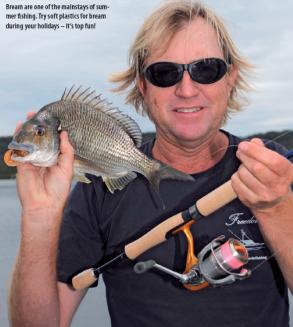KNOTS & RIGS By Mark Williams
THE onset of summer always heralds a frenzied increase in fishing. Hot weather is conducive to good fishing for a wide range of species and the balmy conditions brings anglers out in their droves. It doesn’t matter if you’re a once-a-year holiday fisho or a diehard piscatorial fanatic – everyone wants a piece of the action. For those of you who’ve had their rods and reels sitting in the back corner of the garage over winter it’s now time to do some work and get your tackle ready for action.
Generally speaking, the longer your fishing gear is left unused, the more maintenance is required to get it ready for battle. If you’re mechanically inclined, a full strip down, clean and lube of each reel is recommended. Pay particular attention to sticky drags systems, ensuring bail rollers on threadlines are spinning freely and that level wind mechanisms on baitcasters are well lubricated. A good general maintenance regime for all types of fishing reels would include lubrication of all reel handles, bearings and bushes.
If you’re not mechanically minded, take your reels to your local tackle shop for a full service.
Modern fishing rods require much less maintenance than the outfits of yesteryear. Apart from the washing down ritual at the end of each trip, you should check fixed rod guides for cracks or chips in the ceramic inserts and ensure roller guides are turning freely and are well lubricated. Most tackle shops will replace damaged fishing rod guides for a small fee, so it’s no drama to have your gear in top working order without the need to own heaps of rod building gear.
Line loads on reels also require inspection prior to the start of a new fishing season. For those outfits loaded with monofilament that haven’t been used for many months I’d be inclined to strip the line off and bin it. Monofilament lines tend to develop memory problems when stored on reels for long periods and the stuff is relatively cheap these days so if you want tangle free fishing, ditch the old stuff. There’s a wide range of monofilaments on the market these days, but I try and avoid the cheap and nasty stuff and stick to the quality brands with a good reputation such as Rovex 10X Formula. If you do decide to go with the cheaper stuff be warned that you will need to replace it regularly or it will cost you fish in the long run. My favourite knot for connecting my line load to the reel spool is the Uni Knot. The knot can be formed well clear of the reel body and slid down into position during the tensioning process. I always take a number of wraps of line around the spool hub before tying the Uni Knot. This minimises the risk of the line load slipping on the reel spool especially when used in conjunction with the Uni Knot as it really locks down on the spool when tensioned correctly.
Check out a video – http://www.fishingworld.com.au/news/video-how-to-tie-a-uni-knot – at the Fisho site for more info on this knot and study the illo opposite by Chris Palatsides.

Braided gelspun lines don’t suffer the memory issues monofilament lines do so they can be stored on reel spools for longer periods. I’d still be inclined to replace any GSP line loads at the beginning of a new fishing season, especially if I knew the reels had done a significant amount of work the previous season. In the big scheme of things fishing line is a relatively inexpensive part of the game, yet it’s the one thing that connects you to the fish, so it pays to keep decent line on your reels.
Tackle boxes can always use a clean out at the beginning of a new fishing season. Ditch any rusty hooks as they’ll cause corrosion to go through your tackle box like a feral cat through an aviary. Have a good look at the consumable items you’ll need for another season and stock up. Classic examples include hooks, sinkers, swivels, split rings and snaps. Leader material is always something that I seem to have to buy at the beginning of each season; these days I seem to be using primarily fluorocarbon for my light lure and fly fishing work. Hard monofilament is still great for the high abrasion, medium to heavy tackle scenarios and you’ll need wire trace for dealing with the razor gang such as Spanish mackerel and wahoo.
Other pieces of piscatorial paraphernalia that I stock up on at the beginning of each season include sunscreen, sun gloves, lip block, hook sharpeners, split ring pliers, gelspun scissors and, most importantly, a fishing licence (if you plan to fishing in NSW and/or Victoria).
Finally, if you haven’t been fishing for an extended length of time it may pay to do some rigging practice. Even experienced knotologists can tie a dud knot if they’ve been out of the rigging game for a while. Have a practice run on the most frequently used knots in your rigging arsenal and get a feel for forming and tensioning them up again. Practice tying them in the material you’ll be fishing with; that way you’ll know how many turns are required in each connection when you’re out on the water in the middle of a hot bite and need to do it right the first time. A practice session in front of the TV is a good opportunity to pre-rig a heap of leaders in preparation for the great fishing you’ll experience
this summer!

















